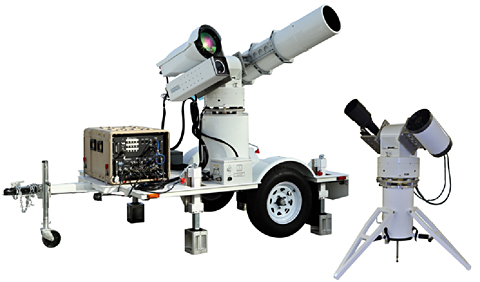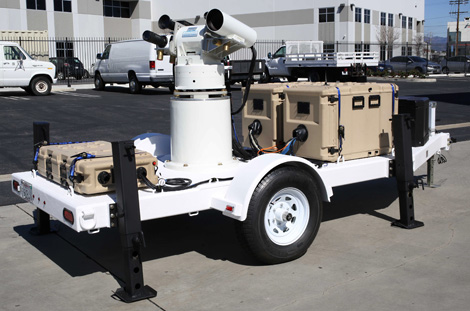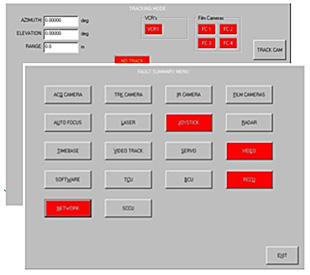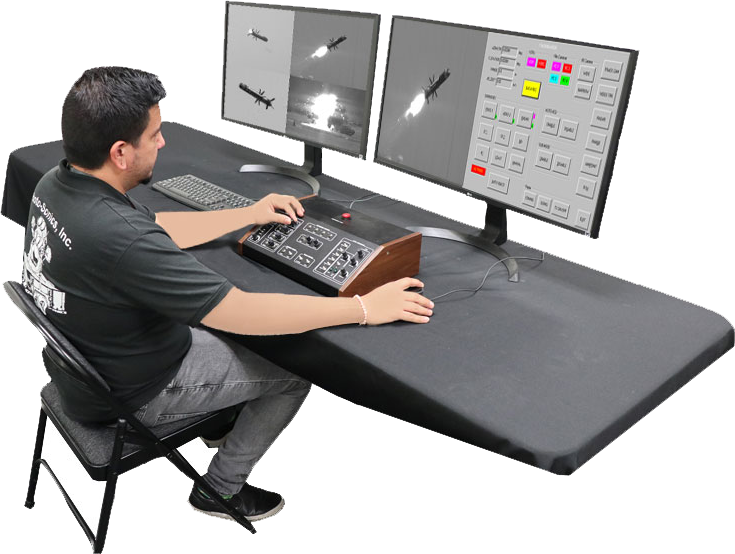 The Nano-Sextant tracking mount is optimized for close-in tracking of high-dynamic airborne targets near
the launch or termination stage of an event. Its compact design is
ideally suited for small, lightweight sensors and optics best suited for capture
of high-resolution images for Engineering Sequential Data (ESD) missions. Yet
the Nano-Sextant has the necessary accuracy, payload capacity and dynamic
performance to be member of a larger Optical Tracking network, gathering
high-accuracy Time-Space-Position-Information (TSPI) data.
The Nano-Sextant tracking mount is optimized for close-in tracking of high-dynamic airborne targets near
the launch or termination stage of an event. Its compact design is
ideally suited for small, lightweight sensors and optics best suited for capture
of high-resolution images for Engineering Sequential Data (ESD) missions. Yet
the Nano-Sextant has the necessary accuracy, payload capacity and dynamic
performance to be member of a larger Optical Tracking network, gathering
high-accuracy Time-Space-Position-Information (TSPI) data.
Nano-Sextant attached to a riser pedestal and mounted on a trailer. The containers on the trailer house recording devices and equipment that establishes a microwave or fiber optic link to the control console.
 Configuration -
The Nano-Sextant was designed for use under various deployment
scenarios. The baseline configuration can be ordered with a
ruggedized tripod, yet is small enough to be placed on an elevated
tower to provide a better view of the event, avoiding the
atmospheric effects near the ground including scintillation, heat
shimmer, smoke and dust. For maximum portability, the
Nano-Sextant can be installed on a 7-foot trailer for rapid
deployment at semi-developed locations.
Configuration -
The Nano-Sextant was designed for use under various deployment
scenarios. The baseline configuration can be ordered with a
ruggedized tripod, yet is small enough to be placed on an elevated
tower to provide a better view of the event, avoiding the
atmospheric effects near the ground including scintillation, heat
shimmer, smoke and dust. For maximum portability, the
Nano-Sextant can be installed on a 7-foot trailer for rapid
deployment at semi-developed locations.
Payload Flexibility - Depending upon your mission needs, a fully-integrated Nano-Sextant can be configured with a combination of long-range / short-range optics or laser range finders. Payload can be mounted on either of the two vertical side plates of the elevation axis, or on horizontal platforms providing up to four sensor stations. While the recommended maximum total payload is 225 pounds, additional payload may be supported with reduced dynamics and accuracies.
Robust Pedestal Construction -Photo-Sonics
utilizes Almag‑35, an aluminum-magnesium alloy, which provides
excellent corrosion resistance to support long life with minimal
maintenance in the harshest environments. We use only
full-size bearings to provide the highest stability and accuracies,
as opposed to narrow-diameter bearings found in lesser systems. Powerful,
low-maintenance DC torque motors are provided in both the azimuth
and elevation axis, and are coupled to the 23‑bit absolute-position
Inductosyn® encoders.
Pedestal Support ElectronicsThe electronics support several installation scenarios. A single enclosure, containing the Digital Servo Amplifier (DSA) and the main I/O panel are packaged in single enclosure at the pedestal site. The remaining electronics such as the Base Computer Unit (BCU), Video Switches, Video Trackers, Recorders, etc. are installed in the Operator’s Console which can be located in a mobile Operations Van or at the user’s Mission Operation Center.

Control Software - The ARGUS control software provides all the functionality the user would expect of an advanced TSPI tracking system. It provides a single interface for the tracking pedestal, sensors, auto-tracking, ranging devices, calibration, target simulation and diagnostics of the complete tracking system. Control of the system is simplified via an intuitive touch screen GUI. The standard ARGUS application can control up to 10 sensor stations, in addition to ranging devices, allowing a single operator complete control of all aspects of a complex and highly capable system from a remote location. It also provides the control of single and dual-gate auto trackers and fixed focal length and zoom lenses and focus tables. Automated Star Calibration and Turn-and-Dump Calibration are incorporated to yield the highest TSPI accuracy of any optical tracking system manufactured today.
Visit the ARGUS software page.
Operator Console - Photo-Sonics offers a variety of console configurations, from our full-size console (for location in mission control center) to a smaller, compact console suitable for mobile command vehicles or multiple packing cases for easier transportability. The default connection between the pedestal and the remote console is via a single-strand, single-mode 'dark' fiber optic cable, which allows for up to 20-40 km separation. Alternative Interfaces, including shared fiber optics and microwave, are also supported.
A standard console consists of the following items:
· 19" Touch-Screen Monitor
for the main GUI interface
· Video Monitors
(2, 3, or 4 screens available)
· Operator Control Panel
· Mini Keyboard with Control
Stick and Operator Controls
· Console Computer
· I/O Panel (Fiber optics,
Ethernet switches)
· Optional UPS
Installation Options:
The compact, light-weight design of the
Nano-Sextant easily supports several
installation options:
· Fixed site
· Ruggedized Tripod
· Customized Trailer
· Tower mounting
*specifications subject to change

| System Accuracy, Fixed Mount |
±20 arc-seconds (100 micro-radians), 2σ |
| Bearings |
14.75” diameter azimuth thrust bearing 7.5” diameter elevation ball bearing |
| Drive System |
Direct drive DC torque motors (brush type |
| Torque |
Azimuth : 40
foot pounds Elevation : 40 foot pounds |
| Velocity (Nominal Payload) |
Azimuth : 120°/second Elevation : 120°/second |
|
Acceleration (nominal payload |
Azimuth : 120°
sec² Elevation : 120° sec²² |
| Closed Loop Servo Bandwidth |
Azimuth : 18
Hertz Elevation : 25 Hertz |
| Nominal Payload |
225 pounds total (at rated payload moment of inertia design specification) |
| Non-Orthogonality | ± 10 arc seconds |
| Encoders | Azimuth and Elevation, 23-bit Inductosyn® |
| Elevation Travel | -30° to +210° |
| Azimuth Travel |
±270° |
| Transit Locks | Locking stow pins in AZ and EL every 90° |
|
Weight (with no payload |
140 pounds (base unit) |
| Height | 20” (bottom of azimuth axis) |
| Power | Single-phase European or US AC power |

Photo-Sonics, Inc.
818-842-2141 (ph - switchboard paging)
818-842-2610 (fax)
mail@photosonics.com